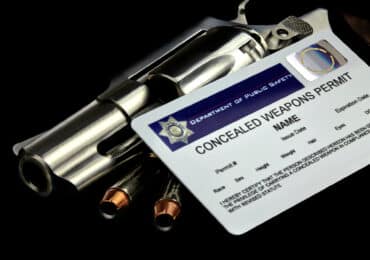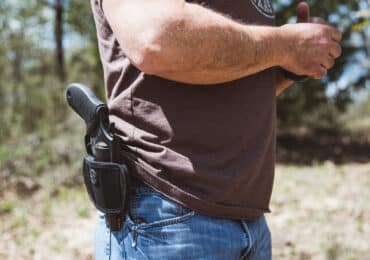Carrying a firearm is a significant responsibility. Ownership of a weapon still sparks discussion and debate nowadays. So, understanding the differences between open carry and concealed carry proves vital for accountable gun owners.

This article outlines the upsides and downsides of each method, spotlights related laws nationwide, and lays out considerations to weigh when deciding how to carry firearms in public legally. You can expect to learn critical factors surrounding this complex issue.
Understanding The Legalities
1. Open Carry
Open carry refers to visibly wearing a holstered handgun in public. Laws vary significantly nationwide. Open carry laws vary widely across states. While some states generally allow open carry with some regulations, others have stricter restrictions or outright bans. For example, open carry in North Carolina only requires being legally able to possess a handgun.
Always check local laws before open carrying, as penalties like fines or jail time can apply for noncompliance. Those supporting open carry argue it exercises Second Amendment rights. Critics dispute this claim and are concerned it intimidates the public.
2. Concealed Carry
Concealed carry is carrying a hidden handgun on your person in public with proper permits. While legal nationally per state laws, permitting requirements vary. Some states require approved firearm safety training courses for safe handling and concealed carry permits, but not all states have this requirement.
Many prohibit concealed weapons in certain sensitive locations, such as government buildings, schools, and hospitals. To many supporters, concealed carry permits responsibly exercise self-defense rights. Opponents contend permitting handguns, even while hidden, risks endangering the public.
Weighing The Pros And Cons
It’s important for anyone considering carrying a firearm to understand the advantages and disadvantages of each carry method. The knowledge helps you make a better decision based on your given situation.
Open Carry
Pros:
Quick Draw – Open carry allows for easier and faster access to your firearm in an emergency. Drawing an openly carried weapon is more rapid if danger arises unexpectedly.
Criminal Deterrence – It may deter potential criminals due to a visible armed presence. The sight of firearms may discourage would-be assailants from targeting an openly armed person.
Right to Self-Defense – Bringing your firearm promotes personal responsibility and Second Amendment rights. Open carry fosters a culture that supports taking accountability for self-defense rights.
Cons:
Potentially Incites Fear – A visible firearm may draw unwanted attention and provoke fear or discomfort. Openly carried guns can unintentionally create public distress and attract undesirable attention.
Possible Accidents – There’s a higher risk of accidental discharge or weapon loss. Retaining control of openly carried firearms presents ongoing safety challenges.
Legal Restrictions – Some locations and businesses don’t allow people to enter or transact with them while with a visible firearm. Many establishments prohibit open carry on their private premises due to safety concerns.
Open-carrying firearms also entails additional considerations. It’s necessary to have the proper training requirements and be socially comfortable with having your weapon out in the open. Securing holsters is also a must to avoid firearm theft.
Concealed Carry
Pros:
The Element of Surprise – Discretion helps in many self-defense situations. Hidden weapons retain a tactical edge if danger arises, unlike visible open-carry firearms.
More Freedom in Other Places – You’ll have wider access to locations that restrict open carry. Concealed firearms face fewer locale prohibitions compared to open carry limitations.
Avoids Negative Social Reactions – Unlike open carrying, a concealed weapon doesn’t incite public alarm. Discreetly carried guns prevent exposing others to distress at the sight of openly armed individuals.
Cons:
Slow Draw – When you hide your firearm, taking it out in an emergency situation may be more difficult. Drawing a concealed weapon requires crucial extra seconds compared to open carry.
Permit Requirements – Conceal carrying requires obtaining a permit and potentially attending training. Licensing concealed carry involves meeting state requirements like safety courses.
Legal Issues – You may face legal risks if your permit lapses or if you violate carry laws. Failure to properly follow concealed carry protocols can bring criminal penalties.
Even with this method, you must consider factors like comfortable concealed carry clothing, quality holsters, and printing visibility through garments.

Making An Informed Decision
Carefully reflect on your personal routine, habits, and needs when weighing open versus concealed carry options. An urban professional may prefer concealed carry accessibility, while a rural worker expects faster access to deter aggressive wildlife. Seek professional training tailored to your carry method of choice to ingrain vital safety protocols.
Additionally, stay updated on laws in all jurisdictions you travel through, as concealed permits do not transfer across state lines. Both carry options demand rigorous discipline in the safe handling and use of firearms to avoid endangering yourself or others in public spaces. Determine the method most aligned with your lifestyle and commit to the duty and accountability that gun ownership entails.
No matter your choice, remember to keep your firearm secure at home. Whether you decide to open carry or conceal carry, it would be meaningless if someone unauthorized gets access to it and potentially harms themselves or others.
Conclusion
In summary, understanding open versus concealed firearm carry includes both legal implications and practical pros and cons for personal defense needs and lawful compliance. Thoroughly research state laws and weigh the considerations highlighted before deciding. Responsible adherence and training are paramount regardless of the carry method you choose.

